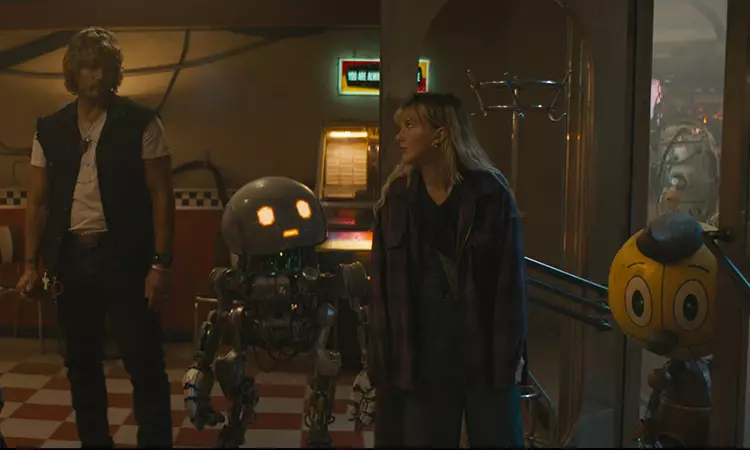In an era where high-concept science fiction often threatens to lose itself in its own ambition, “The Electric State” emerges as a cinematic feast that audaciously attempts to bridge the gap between visually stunning storytelling and profound thematic exploration. Directed by the Russo Brothers, renowned for their blockbuster Marvel work, this film is an adaptation of Simon Stålenhag’s evocative graphic novel. Set against the backdrop of an alternative 1990s America, it crafts a narrative that blurs the lines between adventure and dystopia, all while beckoning viewers into a world enriched with detail and atmosphere.
At the center of this sprawling narrative is the character of Michelle, portrayed by Millie Bobby Brown. A determined teenager, Michelle’s quest for her missing brother takes her through a landscape ravaged by technological collapse and societal decay. Accompanied by Cosmo, a robotic companion, and the roguish smuggler Keats, played by Chris Pratt, she traverses a desolate environment littered with remnants of a bygone civilization. The film’s visual aesthetic is monumental, capturing the haunting beauty of abandoned highways and colossal robotic relics, a monumental test of world-building that pays homage to Stålenhag’s original artwork. Visually, the film astounds with frames that stand proudly as pieces of concept art, making it feel less like a mere adaptation and more like an immersive experience.
Character Dynamics and Underlying Themes
While the visual splendor is a triumph, the character dynamics often falter, preventing “The Electric State” from attaining its full potential. Michelle’s resilience and vulnerability shine through Brown’s performance, but the script feels constricted when it comes to fleshing her out. The emotional stakes remain tantalizingly out of reach, not for lack of skill on Brown’s part but because the screenplay seems content to sidestep deeper character development for pace and spectacle.
Chris Pratt’s Keats embodies the charming rogue archetype, yet his character feels predictably one-dimensional. Despite Pratt’s natural charisma, the character offers little beyond familiar tropes, echoing roles seen countless times in the genre. The presence of a robotic sidekick, voiced with delightful nonchalance by Anthony Mackie, adds a charming layer but does little to elevate Keats beyond a caricature of brooding masculinity imbued with wit.
The film’s supporting cast boasts heavy hitters like Stanley Tucci, Giancarlo Esposito, and Ke Huy Quan. However, the writing struggles to exploit their talents, leaving many secondary characters feeling woefully underdeveloped. For Tucci, a character imbued with potential menace could have been leveraged in a more fascinating direction; instead, he remains a rather forgettable figure in a narrative that swirls around him.
World-Building vs. Emotional Depth
At its core, “The Electric State” grapples with a dichotomy inherent to many ambitious projects: the balance of world-building with emotional engagement. The brisk pacing, driven by a script from Christopher Markus and Stephen McFeely, ensures that the film never drags, engaging viewers in a series of awe-inspiring spectacles. However, this relentless pace comes at a cost, often sacrificing intimate moments of character exploration that could have elevated the narrative’s heft.
Subtle themes of memory, loss, and humanity’s cyclical relationship with technology flicker beneath the surface but remain largely unexplored. While audiences may walk away with lingering thoughts about the implications of sentient machines, these reflections feel like lost opportunities rather than the crux of the narrative. The ambition is palpable, but without thorough examination, the thematic richness dilutes, leaving some viewers craving greater substance.
A Visual Masterpiece with a Heartbeat of Ambition
Even with its storytelling shortcomings, “The Electric State” remains an engaging odyssey through a beautifully rendered world. The visual experience stands out, ensuring that, should the plot falter, audiences are still captivated by the artistry. In a landscape dominated by cookie-cutter franchises, this film offers a welcome glance into the boundless potential of science fiction storytelling. While it may be unable to fully realize the emotional expedition it teeters on, its breathtaking visuals and poignant moments make it a noteworthy contribution to the genre, a reminder of the delicate balance between spectacle and storytelling. The spectacle alone beckons viewers to embark on this journey; the question remains whether the emotional heart can find its way to the forefront.

